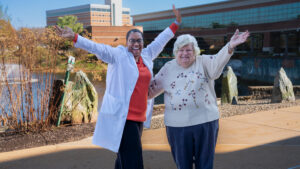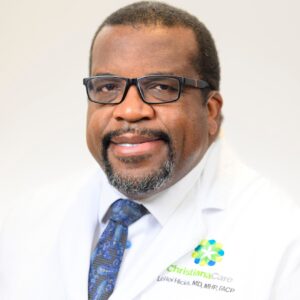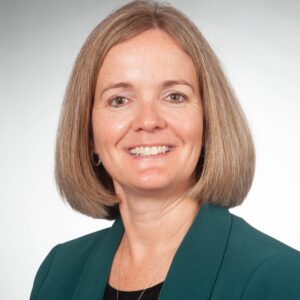Kim Petrella, BSN, RNC-OB, of Christiana Care’s Labor and Delivery Unit, has a passion and commitment for public cord blood banking that resonated halfway around the globe.
It started with leadership by Christiana Care and Petrella to research cord blood banks around the country. This work culminated in a partnership in 2013 with CORD:USE, an organization that prepares cord blood and stores stem cells that eventually can be harnessed to treat diseases that require stem cell transplants.
With colleague Mark Gooss, BS, lab coordinator of the cord blood program, Petrella educates expectant couples on the benefits of banking and donating cord blood, which would otherwise be discarded. Three years ago, a visit to her brother, who lives in the United Arab Emirates, proved another turning point for Petrella.
“He asked me if I wanted to go to the mall in Dubai,” she recalled. “I said I would rather go to the cord blood center.”
Petrella had been reading about the Dubai Cord Blood and Research Center and the work of Fatma Al Hashimi, head of education and development and a clinical scientist. She learned that there was a shortage of public cord blood in Dubai, the most populous city in the UAE. That was especially problematic because about half the people in the UAE are carriers for thalassemia, an inherited blood disease that is more common in people of Mediterranean and Arab descent, and that can be treated with cord blood.
After she returned to Delaware, Petrella kept Al Hashimi up-to-date on cord blood developments at Christiana Care. Since the CORD:USE program was introduced, samples have been collected from more than 2,000 patients. Al Hashimi was so impressed with Christiana Care’s results that she asked her to consult with the Dubai center.
Petrella traveled to the UAE for 18 days in May. She taught 16 classes of up to 100 nurses and midwives at eight different hospitals. In addition to training nurses and midwives about educating patients, Petrella taught collection techniques and proper packaging to keep the cells healthy before they are frozen.
“Before the training, almost all the donations were private — parents saving cord blood in case there was a genetic disease in the family,” Petrella said. “Now, the nurses and midwives report that they are very busy collecting cord blood to be donated to others and now doing so more effectively.”
More than 70 different diseases are currently treated with stem cells from umbilical cord blood, including leukemia, lymphoma and sickle-cell anemia. Some of the cord blood collected at Christiana Care goes to research on curing or preventing Type 1 diabetes, spinal cord injuries, deafness, Alzheimer’s and other diseases and injuries.
Before she returned home, Petrella’s new colleagues in Dubai expressed their thanks by painting a traditional henna design on both her arms. The body art faded after about two weeks, but the memories of her time in Dubai are indelible.
“If people have the opportunity to help another person, they will,” Petrella said. “They just have to know how, which is why it’s so important to educate people about donating cord blood.”



